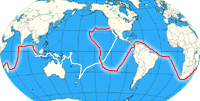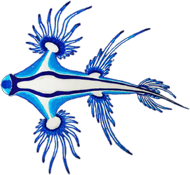Santa Cruz is the most densely populated and changed island of the Galapagos archipelago. There you can also find the biggest town with the most inhabitants - Puerto Ayora. On a small island to the north, called Baltra, is the oldest and biggest airport. Initially used by the military it was also used for tourist flights since 1968 once every two weeks. Since 1975 Baltra is connected with Puerto Ayora with a street and there are more than one flights daily from mainland Ecuador to Galapagos. But only Ecuadorian airlines are allowed to fly to Galapagos because of the strong inspections of luggage, to not import any foreign plants or animals, especially insects.
We are allowed to anchor in Academy Bay, the big bay in front of the main town Puerto Ayora. In contrast to San Cristobal we can use our dinghy here since there is no sea lion colony close by. From the jetty we can observe hunting pelicans and big Blue Herons (Ardea herodias) as well as a lot of baby Black Tip Sharks (Carcharhinus limbatus) and again and again a big group of Golden Rays (Rhinoptera steindachneri) swimming in circles. If you walk along the Avenida Darwin you will reach the Charles Darwin Research Station, short CDRS. There is a nice and new walkway with information about the islands and animals like the Giant Galapagos Tortoises (Chelonoides sp.) and Land Iguanas (Conolophus sp.). The Tortoises as well as the Iguanas are bred here to be released back into the wild.
Since two weeks you can view something very special. In a cooled and darkened building you can see the mortal remains of Lonesome George, the last of the Pinta Tortoises - all others were eaten. After his unexpected death in 2012 when he was „only“ 75 years old, he was preserved in many years of costly and expensive work and finally transferred to Galapagos. For a million of dollars (according to the guide) they built this big building, to keep the preserved remains in an optimal temperature and humidity to last for a long time. That is why only a few people are allowed into the cooled room at a time and take pictures, without flash of course. First you only see a curtain which is opened to show the tortoise. Than the glass behind is opened as well and you can see the vegetation in the background to give the image as if Lonesome George is staying in the wild. But the pose is with a strongly elongated neck, a position those tortoises only adopt when eating leaves which are high up on a bush or tree. Even though they tried for years they could not make him breed with female tortoises. A biologist, who knew him already as a child, told us that he was the laziest tortoise and breeding probably was just too strenuous for him. On our way back to the boat we discover our first Spotless Ladybug (Cyloneda sanguinea). For us this bug looks very funny since it does not have any dots and we only know the European ones with dots.
A trip to the highlands brings us a few encounters with wild Giant Galapagos Tortoises (Chelonoides nigrita). They live peacefully on the farms next to the cattle which are grown here. And it is true what Darwin wrote in his book, that they can not hear very well. When we saw one crossing the street in front of our car the tortoise did not notice us at first. Only when she saw us she let herself fall down with a loud blob and pulled in her feet and head. If you come too close they also make a loud hissing sound. In the park of Chato Dos we were lucky to catch some tortoises mating. First we were only hearing a loud grunting sound. This noise comes from the male which tries with all his strength to mount a female from behind and keep the female motionless with his weight. This is also the reason the male tortoises are much bigger than the females and have a concave carapace. Additionally we watched a male "running" after a female tortoise, luckily the female got away :-) All the eggs, if found, are brought to one of the three breeding stations to help as many of the hatchlings to survive. During the transport the eggs have to be kept in the same position as found in the nests, otherwise the embryo might die. Not very easy to do! What you can also do in the park of Charo Dos is walking through lava tunnels which are illuminated and where owls sometimes nest.
Afterwards we walked around Los Gemolos, a pair of collapse or pit craters, situated in the Scalesia zone the first of four humid zones higher than 180 to 200 m. If you are lucky you can catch a glimpse of the Vermilion Flycatcher (Pyrocephalus rubinus), which sadly we do not see. Even though when we visited it was warm and dry we noticed during the hike through this forest that it must be humid very often in comparison to the coastal areas. On the trees you find a lot of mosses, liverworts, as well as epiphytes like the Galapagos orchid (Epidendrum spicatum), the Galapagos Peperomia (Peperomia galapagensis), which belongs to the pepper plants and has fleshy leaves, as well as the endemic Bromeliad (Racinea insularis), which is closely related to the pineapple plant.
Something very special in Santa Cruz are the huge tree cacti (Opuntia echios, Jasminocerus thouarsii) which form real forests. The Giant Prickly Pear or Opuntia Cactus variation (Opuntia echios var. gigantea) is the tallest one and grows exclusively on Santa Cruz. It can grow up to 12 meters and the trunk looks like one from a proper tree. But it is not woody instead made of layers of fibrous honeycomb material, which is also used for decoration. The funny thing is, that on islands were there are no tortoises or iguanas the same species of cactus grows much smaller. The taller growth must be related to the tortoises and iguanas eating the leaves and fruits which are an important source of food for them. Like the flowers are important for the Cactus Ground Finch (Geospiza scandens) which uses the cacti also for nesting. We observe some of them feeding as well as a pair mating. They have the longest beak out of all the Darwin Finches.
On the way to Turtle Beach, which is a 2,5 km walk through the arid zone with lots of cacti again, we can also see a Woodpecker Finch (Camarhynchus pallidus). Those are the only finches to use a tool. Generally a cactus spine or twig is used to dig beetle larvae out of rotten wood. Also lots of Galapagos Mockingbirds (Nesomimus parvulus) are running around on the walkway. The name comes from the "mocking" or imitating of the songs and calls of other birds. They are excellent mimics and have even learned to imitate the introduced Smooth-billed Ani. The mocking birds take the ecological place of the starlings in the new world. Those are also the closest relatives within the songbirds. According to some authors the four species of mocking birds which live on the Galapagos islands were more important for Darwin's evolution theory than the finches. During Darwin's stay on Galapagos he was fascinated by the four different species of mocking birds because they looked very similar to the ones living on the mainland but also had differences to them. It was so important for him that he exactly labeled all of them in contrast to the finches which he did not label.
Once you reach the ocean you are at the beginning of the Turtle Beach which stretches about a kilometer in a westerly direction. It is an important nesting beach for the Galapagos Green Turtle (Chelonia mydas agassis) and closed to the public between 6 pm and 6 am. We can at least see one fresh turtle track in the sand and observe lots of pelicans and gulls hunting in the surf. Also some Marine Iguanas (Amblyrhynchus cristatus hassi) are walking on the beach, but most of them we find art a small tide pool at the end of the main beach. There you can also see them swimming and can snorkel with them as well as see them basking in the sun. Sometimes up to 6 of them are lying next to each other and do not get disturbed by all the people. If you continue walking you reach another smaller beach within a very shallow bay where sometimes young sharks and rays are swimming around. You can basically stay here all day and watch and observe the different animals. We really enjoyed this beach a few times.
Back in Puerto Ayora we visit La Grieta which is a crevice in the rock filled up with brackish water the town also uses for their water supply. The temperature of the water is cold in comparison to the ocean water. It is quite clear except the salty and not so salty water do mix. It is fun to swim and snorkel there and look fors the fish. There are even some small Marine Iguanas sitting on the edge of the water and a local shows us some tunnel and holes to dive through. Very refreshing in the heat of the day!
Academy Bay itself can be explored by kayak with a small track towards Playa Perro on the western end. There you can reach two small beaches with Marine Iguanas while walking through an impressive cacti forest. On the anchorage we often see hunting sea birds, a big Black Tip Shark swimming around in the late afternoon, as well as once in a while a sea lion. There is really a lot to do and see on Santa Cruz but now we are looking forward to visiting Isabela, which is supposed to be more quiet and has the most beautiful anchorage of all three islands.



_with_a_wingspan_of_nearly_2_meters_hunting_near_the_fishmarket.jpg)
_seems_to_be_permanently_around_in_Academy_Bay.jpg)

_with_a_dome-shaped_carapace_have_feeding_time_at_the_breeding_center_CDRS.jpg)
_with_a_pronounced_saddleback.jpg)
_are_threatened_due_to_introduced_animals_which_feed_on_their_eggs_the_young_and_the_adults.jpg)






.jpg)

_living_on_Santa_Cruz_again.jpg)





.jpg)
_on_the_trees_around_Los_Gemolos.jpg)
_a_herb_with_fleshy_leaves_growing_on_a_Tree_Scalesia.jpg)
.jpg)


_who_feeds_on_the_flowers_of_the_Opuntia_Cactus.jpg)
_can_grow_up_to_12_meters.jpg)
_watching_us_from_above.jpg)
_which_was_important_for_Darwins_evolutuion_theory.jpg)
.jpg)


_are_breeding_on_Galapagos.jpg)
_looking_for_food_on_the_beach.jpg)


_swimming_back_ashore_after_feeding_on_algae.jpg)
_between_the_mangroves.jpg)
_coming_close_while_looking_for_pieces_of_our_bread.jpg)


_was_very_interested_in_our_lunch.jpg)


_which_is_found_on_ten_islands.jpg)
_grows_up_to_2,5_cm.jpg)

_resting_in_Academny_Bay.jpg)


_were_resting_in_the_shade.jpg)
_can_be_found_everywhere.jpg)
_are_running_at_the_surface_of_the_water_which_looks_like_dancing.jpg)
 >>planned route - join us ...
>>planned route - join us ...